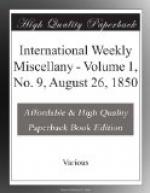“Of which it is advisable carefully to keep to the windward.” Mr. Wilkinson observed.
“The most curious thing about carbonic acid gas,” proceeded Harry, “is its weight. Although it is only a sort of air, it is so heavy that you can pour it from one vessel into another. You may dip a cup of it and pour it down upon a candle, and it will put the candle out, which would astonish an ignorant person; because carbonic acid gas is as invisible as the air, and the candle seems to be put out by nothing. A soap-bubble or common air floats on it like wood on water. Its weight is what makes it collect in brewers’ vats; and also in wells, where it is produced naturally; and owing to its collecting in such places it causes the deaths we so often hear about of those who go down into them without proper care. It is found in many springs of water, more or less; and a great deal of it comes out of the earth in some places. Carbonic acid gas is what stupefies the dogs in the Grotto del Cane. Well, but how is carbonic acid gas made by the candle?”
“I hope with your candle you’ll throw some light upon the subject,” said Uncle Bagges.
“I hope so,” answered Harry. “Recollect it is the burning of the smoke, or soot, or carbon of the candle, that makes the candle-flame bright. Also that the candle won’t burn without air. Likewise that it will not burn in nitrogen, or air that has been deprived of oxygen. So the carbon of the candle mingles with oxygen, in burning, to make carbonic acid gas; just as the hydrogen does to form water. Carbonic acid gas, then, is carbon or charcoal dissolved in oxygen. Here is black soot getting invisible and changing into air; and this seems strange, uncle, doesn’t it?”




